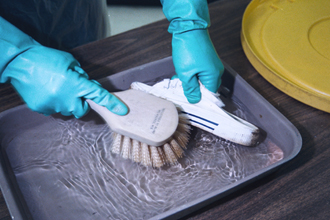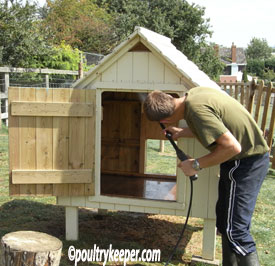- Wear gloves to protect yourself from chemicals and disease.
- Remove all visible matter from surfaces. Dirt and other organic materials may prevent disinfectant from reaching the site of contamination.
- Wash with hot water and detergent (laundry or dish soap).
- Scrub with brushes.
- Rinse after a few minutes with hose or power washer.
- Apply disinfectant.
- Rinse after a few minutes with hose or pressure washer, using top to bottom direction.
References for this section: 7,13
|
|

USDA APHIS
|
Avoid using wooden crates or reusable cardboard cartons as these materials are harder to clean and disinfect. Consider lining wooden equipment (such as crates or cages) with plastic to facilitate better decontamination.
Poultry Housing(Clean as needed)
- Wear gloves to protect yourself from chemicals and disease.
- Remove all debris such as bedding, feed, and manure.
- Sweep out loose materials such as dirt and feathers.
- Scrub and spray housing with detergent to remove remaining organic materials.
- Rinse detergent after a few minutes with hose or power washer.
- Using a pressure sprayer, apply the disinfectant to the poultry house.
- Wait a few minutes and rinse with a hose or power washer, using a top to bottom direction.
- Allow housing to dry completely before adding new litter, feed, and water.
Keep equipment and houses organized so they are easier to clean.
|
|

|
Sanitizing Poultry Drinking Water
If you use ponds, streams, or wells as your source of drinking water for your poultry, you should consider adding a sanitizer such as chlorine to the water. This will reduce the level of harmful organisms and other infectious agents in the water and prevent the buildup of slime in your waterers.
- Bleach may be used to sanitize water by adding 1 oz of bleach to 1 gallon of water.
- If giving a vaccine through the drinking water, stop using bleach to sanitize drinking water 2 days prior to vaccination as bleach will inactivate the vaccine and make it ineffective.
- Clean waterers and replenish with fresh water daily.

